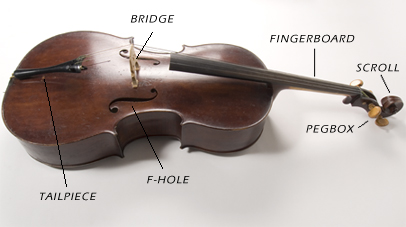
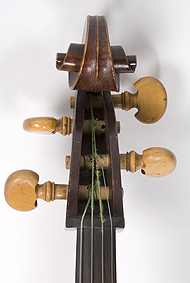
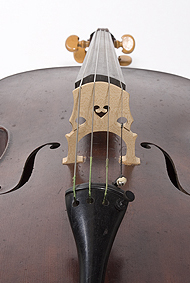
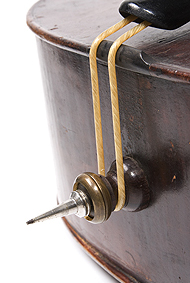
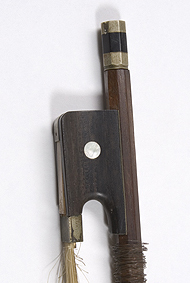
Parts Of The Violoncello
Body
A traditional violoncello (or cello) normally has a spruce top, with maple for the back, sides, and neck. Other woods, such as poplar or willow, are sometimes used for the back and sides. The top and back are traditionally hand-carved. The sides, or ribs, are made by heating the wood and bending it around forms. The cello body has a wide top bout, narrow middle formed by two C-bouts, and wide bottom bout, with the bridge and sound holes just below the middle.
Neck, Pegbox, and Scroll
The neck, pegbox, and scroll are normally carved out of a single piece of wood. The fingerboard is attached to the neck and extends over the body of the instrument. The nut is a raised piece of wood, where the fingerboard meets the pegbox, which the strings rest on. The pegs are used to tune the cello by either tightening or loosening the string. The scroll is a traditional part of the cello and all other members of the violin family. Ebony is usually used for the tuning pegs, fingerboard, and nut, but other hardwoods, such as boxwood or rosewood, can be used.
Bridge and f-holes
The bridge elevates the strings above the violoncello and transfers their vibrations to the top of the instrument and the soundpost inside. The bridge is not glued, but rather held in place by the tension of the strings. The f-holes (named for their shape) are located on either side of the bridge, and allow air to move in and out of the instrument to produce sound.
Tailpiece and Endpin
The tailpiece is traditionally made of ebony or another hard wood. It attaches the strings to the lower end of the cello, and can have one or more fine tuners. The endpin supports the violoncello in playing position. Modern endpins are retractable and adjustable; older ones were made of wood and could be removed when not in use.
Bow
Traditionally, bow sticks are made from Pernambuco (high quality) or brazilwood (lower quality). Both woods come from the same species of tree (Caesalpina echinata), but Pernambuco is the heartwood of the tree and is much darker (Brazilwood is stained/painted dark to compensate). The bow hair is traditionally horsehair which is coated with rosin, a solid form of resin noted for its friction-increasing capacity. The hair is kept under tension while playing by a screw which pulls the frog (the part of the bow one holds) back.
Internal Features
Internally, the violoncello has two important features: a bass bar, glued to the underside of the top of the instrument, and a round wooden sound post, wedged between the top and bottom plates. The bass bar supports the violoncello's top and distributes the vibrations. The sound post connects the back and front of the violoncello. Like the bridge, the sound post is not glued, but is kept in place by the tensions of the bridge and strings. Together, the bass bar and sound post transfer the strings' vibrations to the body of the violoncello, which in turn transfers them to the air mass inside the instrument, producing sound.
Bibliography
Harvey, Brian W. The Violin Family and its Makers in the British Isles: an illustrated history and directory. Oxford: Clarendon Press, 1995.
New Grove Dictionary of Musical Instruments. (ed.) Stanley Sadie. London: Macmillan 1984 3 vols.
cellowiki.wetpaint.com
Images reproduced courtesy of the Historic Houses Trust of New South Wales. © All rights reserved
 Violoncello home page
Violoncello home page




